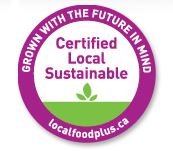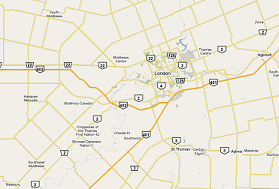 Local Food Plus is a non-profit organization in Toronto that certifies sustainable farmers and producers, while working to help institutions of all kinds commit to purchasing food from certified farmers and partnering food purchasers/distributors with certified farmers. In the end, Local Food Plus (LFP) is creating a win-win situation for everyone; farmers make a decent living off their crops, distributors continue to compete for contracts and making it easier for consumers to bite into local, sustainably grown produce.
Local Food Plus is a non-profit organization in Toronto that certifies sustainable farmers and producers, while working to help institutions of all kinds commit to purchasing food from certified farmers and partnering food purchasers/distributors with certified farmers. In the end, Local Food Plus (LFP) is creating a win-win situation for everyone; farmers make a decent living off their crops, distributors continue to compete for contracts and making it easier for consumers to bite into local, sustainably grown produce.
I recently sat down to have a conversation with Chris Alward, Director of Market Development at Local Food Plus. We talked about LFP’s funding, how things are going and next steps.
As a follow-up to comments I made here about LFP’s seemingly “Toronto-centric” approach, Chris explained that this is in part to do with where LFP’s funding comes from and where funders want to see their money go. It makes sense for LFP to concentrate on Toronto to start, but efforts are already underway to expand the reach of the program, and indeed there are several farmers in the London area that LFP has certified. Chris stated that, at the end of the day, “The majority of mouths that need feeding are in urban centres.”
Who Funds Local Food Plus?
I asked Chris about where LFP’s funding comes from. He said that the majority of funding has come from the Greenbelt Foundation, the Ontario Trillium Foundation, the province of Ontario and also from the Metcalf Foundation. LFP also maintains a full list of funding sources on its “Funders and Supporters” page.
As an example of the funding driving the agenda, Greenbelt’s focus for LFP is on developing certified farmers within the greenbelt and finding more buyers in Toronto.

One of Local Food Plus’ larger areas of focus is the scalability of an alternate food system. Chris went onto explain that the current system is pretty efficient and that the transportation of food doesn’t do as much damage as many of the other factors do. In fact, Chris cited recent studies showing that transportation of food may account for as little as 8% of the greenhouse gases generated by the existing food cycle, while over 50% has to do with the production of food.
Another problem is the average of farmers; it’s approaching 60 years old, and many organizations are citing this as a massive concern going forward when it comes to food security and economic stability both on and off the farm; if Ontario lacks farmers coming into the system, more and more of our food will come from other provinces and countries. Chris also cited a study showing that if the U.S. border was closed for just three days, Toronto would run out of food. That number differs for other cities, but it shows that Canada’s biggest city and metro area should have food at the forefront of the issues they’re trying to tackle.
How Does Local Food Plus Approach Sustainable Food?
Something interesting I found out of the discussion was that Local Food Plus does not use environmental arguments at all for showing why local, sustainable food is the way to go. In fact, it’s mostly based on economics and food security. Again, some new research has shown that locally grown and transported produce has no better impact on the amount of greenhouse gases generated than something brought in from far away.
How does that work? Well, it really depends on what you’re moving and how. You could have a transport truck moving thousands of chickens from Kentucky to Ontario, and consumers would then drive to their local grocery store. Conversely, you could have thousands of people driving from their homes to a farm that could be 20-30km away. The amount of GHGs generated in each scenario is likely pretty similar.

In the end, LFP is focused on getting farmers more money while ensuring food is still affordable for consumers. In fact, there typical premium for produce made by Local Food Plus’ standards is approximately 10-15%. Personally, I believe that’s a very small price to pay to know that local farmers are making a good living. Really, isn’t it worth paying 55 cents for an Apple grown nearby compared to paying 50 cents for an Apple grown in Bellevue, Washington?
LFP has certified over 200 farms, and approximately 30% of those are also certified organic. LFP’s approach is different because it allows their certified farmers to use chemical, but only enough to manage the problem – LFP certified farmers must commit to first apply the lowest impact productions possible. LFP certified farmers also spray a lot less chemicals than the average farmer and spray more of the “soft” chemicals before escalating to the harsher pesticides we would all rather see go away.
LFP also has their farmers display a commitment to biodiversity, protecting their land and natural species in the area. Certified farmers must commit not to farm every part of the property; a portion of the farm must be left alone to simply let the land thrive on its own. Studies and stories from farmers have actually shown that this helps with natural pest management. One example Chris told me about was that some very innovative farmers have begun planting a ring of eggplants around their tomato and pepper crops. Apparently many pests enjoy eggplant much more than humans do, and so when they descend onto the farm, they attack and eat the eggplant while leaving the other crops alone! Incredible!
LFP has taken this and other examples of biodiversity to farmers, educating them on what they can do to foster natural pest management for controlling their farm.
How is Local Food Plus Doing?
I asked Chris to tell me how things are going for Local Food Plus. He said that the organization is growing by leaps and bounds “in the right way.” LFP is receiving plenty recognition, certifying more and more farmers, and getting more commitments from buyers to go to LFP certified farms. Currently LFP is adding approximately 50-75 farms per year, has commitments from over 70 wholesale buyers, and a significant part of their work right now is working with food distributors, meat counter managers, chefs and wholesale buyers to make more connections.
The good news is that working with wholesale buyers to begin shifting their spend to LFP-certified farms isn’t usually very hard. LFP asks for a commitment to shift just 10% of their spending to start, working with buyers to increase that number over time.
When I asked about any large partnerships other than the ones I had read about in The Walrus last summer, Chris let me know that working on institution level agreements is a policy issue first, so it’s different than working with other organizations. However LFP is hard at work encouraging school boards to bring healthier menus to students.
One big success story is the University of Toronto: 18% of their food is coming from LFP certified sources now, and next year that will increase to the low 20s. LFP works with the companies that get these contracts, like Sysco and Summit Foods, to make sure they get access to the food stipulated in the contract and LFP has relationships with all of the major distributors and that is making working to get commitments from large institutions even easier.
How Does the London Area Fit In?
 One thing I wanted to ask is what does this all mean for the London region? Chris was able to tell me that they have knowledge of when places like UWO and Fanshawe have the food contracts coming up for renewal. LFP has also certified several large farms in the London area that can supply food very quickly – at this point, LFP is really just waiting for funding in order to make a more aggressive push into the London area. Chris made sure to note that London is a significant urban centre surrounded by lots of farmland and that it’s relatively easy to move food from here and there is a small satellite office in Granton.
One thing I wanted to ask is what does this all mean for the London region? Chris was able to tell me that they have knowledge of when places like UWO and Fanshawe have the food contracts coming up for renewal. LFP has also certified several large farms in the London area that can supply food very quickly – at this point, LFP is really just waiting for funding in order to make a more aggressive push into the London area. Chris made sure to note that London is a significant urban centre surrounded by lots of farmland and that it’s relatively easy to move food from here and there is a small satellite office in Granton.
I ended the call by telling Chris that I think Local Food Plus should initially focus its efforts in London on places like Remark and Lyn-Dys Health Food as far as getting food to consumers goes. I also said I would let him know of other places of interest, and that if there’s anything I can do I would be happy to help.
Where do you think Local Food Plus should focus its efforts in London? On distributors, stores, farmers? Which ones?